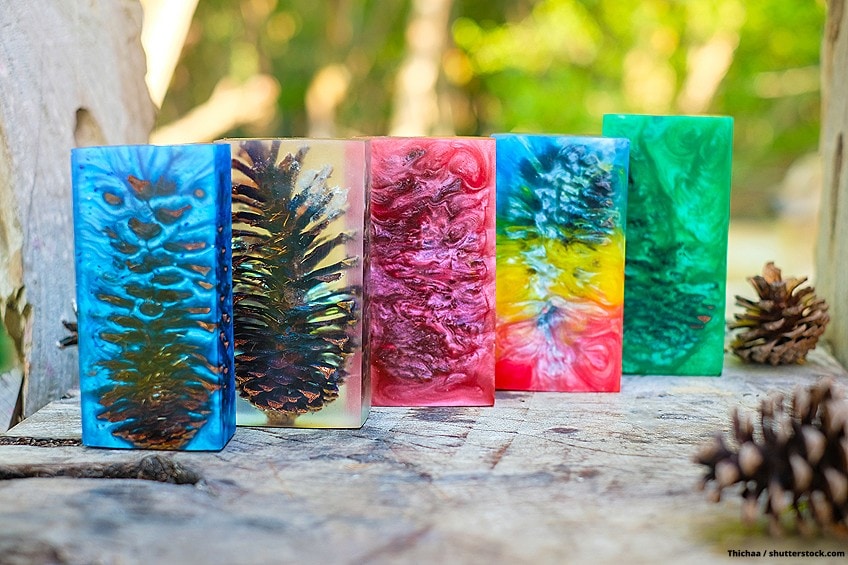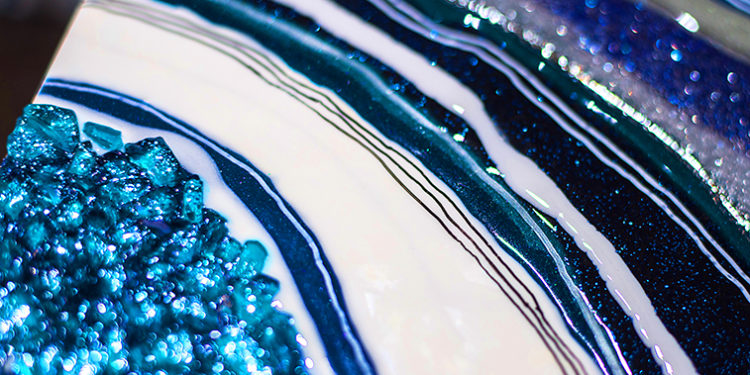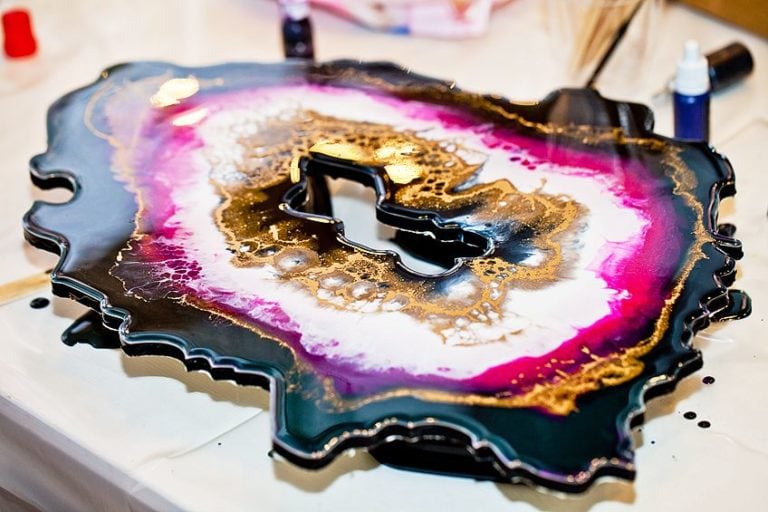Mold Release Guide – The Best Epoxy Release Agent
This post may contain affiliate links. We may earn a small commission from purchases made through them, at no additional cost to you.
Whether you are an artist or just someone at home doing a DIY project, you can create any shape you desire thanks to epoxy resin. There are no limits to one’s imagination, and if you wish to create self-made molds, your options are all the more endless. However, one can struggle sometimes to release the casting from the actual mold. This is where a releasing agent comes into play. The following article will delve into the advantages and disadvantages of epoxy resin release agents and will advise how best to apply the release agents to your silicone molds.
Table of Contents
Is a Release Agent Necessary When Working With Epoxy Resin?
A release agent is a product that is utilized to stop different materials from sticking together. Should you be working with an epoxy resin, you will likely require a release agent in addition to your resin, hardener, and the relevant mold. Be sure to grease your silicone mold with the release agent before using it, thereby ensuring the epoxy resin does not stick to the mold once it has hardened. This is necessary not only for small items, but a release agent is also required if you are working with furniture where you will be embedding the epoxy resin into the material.
If you are making your mold from epoxy resin and glass fiber mats, you will need to coat the negative mold in a releasing agent that works well with epoxy, otherwise you will be unable to release the mold you are creating.
Ensure that you completely coat the mold with the epoxy resin releasing agent, making sure that there is no direct contact between the mold and the resin. If you allow the resin to adhere directly to the mold during the curing process, you will damage the mold and not achieve the desired outcome.
Most releasing agents that have been manufactured for epoxy resin can also be used for polyester resin, and some of them can even be used for polyurethane resin. An epoxy resin release agent is not ideal for wood, however, as wood is porous and therefore absorbent. Wooden surfaces need to be sealed before you treat them with any release agent. If you do not seal the wood first, any releasing agent applied will be completely absorbed. The same will apply for plaster and foam. In the remainder of this article, when we refer to an epoxy resin release agent for wood, we are assuming that the wood has been sealed.

Which Epoxy Release Agent Should I Use?
Your options in terms of a release agent for epoxy resin are between a release spray, a release wax, or a release lacquer. The application and mold you require will dictate which one you need to use. If you are working with a detailed, small mold, we recommend using a release spray, as it will allow the releasing agent to get into all parts of the mold. Release waxes are best used for large, flat surfaces, and release lacquers work well as a means of polishing your resin whilst demolding it.
Release Spray
The release spray works as a combination of aerosols and wax. The aerosol is a carrier material, to which you can then apply the wax as a protective layer over the mold. The wax layer will remain on the mold, but the aerosol evaporates quickly.
If you have a mold that has a lot of small corners and edges, the release spray is perfect, as the spray ensures that the release agent is evenly distributed on all parts of the mold. If you are looking to take it to the next level and achieve a very even surface when using epoxy resin in conjunction with the release agent, you can always polish the surface once you have finished spray, however, this isn’t something that has to be done.

Application
To begin, you need to remove any dirt residue, oil, and grease from the substrate. This is relevant not only to the release spray but also to PVA release lacquers and release waxes. Grease and oil will not allow the release agent to adhere to the surface, as these substances cause the release agent to simply float on the surface and do not allow its properties to develop. Once cured, these residues will have mixed into the resin and stuck to the mold, thus causing a lot of damage.
Once the surface has been completely cleaned, make sure you shake the can of release spray well, after which you can begin spraying the mold with a thin layer of releasing agent. When spraying, hold the spray can at least 20 to 30 cm away from the mold and ensure that you cover all areas of the mold. If you want to polish the release film, allow the spray to sit for 2 to 3 minutes before polishing, which can be done using a soft, lint-free cloth.
If the mold is new, you should treat the mold at least three times. Once each spraying has been completed, allow the mold to flash overnight.
STONER Mold Release Spray
Stoner Release Spray with Wax is a mold release agent that can be utilized on an assortment of materials. It assists with the easy removal of the resin casting and gives the user pleasant and easy handling. This product will save you time, as it allows any urethane-based parts to be released from the mold quickly and easily.
- Formulated to provide high levels of safety
- Lets casting release quickly and easily from the mold
- Colorless and non-staining
Using this release spray will also improve the appearance of your cured resin piece and will reduce the likelihood of damage caused by sticking. This product has been formulated so as to be safe for you as well as the environment, and contains no ozone-depleting substances or other harmful chemicals. It is also colorless and will not stain.
We highly recommend you use Stoner’s release spray, as it offers you all the required properties to ensure that you can release a casting from epoxy resin. If you are working with silicone, however, we recommend you rather use a release petroleum jelly or a release wax.
Pros
- It is very versatile and can be used on small, detailed shapes, as well as over large areas.
- It allows for perfect demolding and a top-level release effect.
- It is a great option for porous materials, which makes it an ideal epoxy resin release agent to use with wood. Be sure to apply the release agent in several thin layers when using it with wood.
- It is easy and quick to use.
- It can be used for polyester resin, PMMA, casting resin, and polyurethane.
- This release spray does not contain any silicone or greenhouse gases.
Cons
- This release agent does not work if you wish to separate silicon from silicon.
Release Wax
Unfortunately, you are unable to purchase release wax in a spray can form, as it only comes in wax form. It is a very liquid wax, however, that you can easily remove from the container simply using a cloth. You just open the container and pour the liquid wax onto the cloth, after which you can wipe it over your silicone mold.
Once you have used the wax to treat the mold, you will be left with a matted surface. You can use a lint-free cloth to polish this so as to make the surface appear shiny.
Application
Release wax is perfect if you are working on a flat, large surface. Rather use a release spray to coat smaller details, as you may struggle to get the release wax evenly into the smaller angles when using a cloth. If you have used the mold many times, be sure to thoroughly clean any wax residue before reusing it. You can clean it using some steel wool and warm water.
It is imperative to ensure that the release wax is shaken well before use, which will ensure that the solvent and wax have recombined, as they can separate if they have been in storage for a long period. Once you have shaken the product, you can use a spatula and apply it with a clean, lint-free cloth. Allow five minutes and then you can polish the release wax using a clean cloth. If you are using a new mold, ensure that you apply a second coat, allowing one night between each release coat.
If you are looking to achieve a shiny surface, you can also treat the wax release layer using a PVA release lacquer.
ORCA Shimmer Mold Release Wax
You can use Orca Shimmer Mold Release Wax on an assortment of resin. It is a highly concentrated wax that produces excellent results. This release wax can be used with PVA release lacquers to create additional shine, although this is not necessary if you polish the wax sufficiently.
The flash-off time is very important when you are using this wax, so you need to observe this to ensure that the wax and resin do not mix. Allow a tack-free film to form before pouring the resin into the mold. It is not ideal for use with wood, however. For wood, you should instead use a release lacquer or sealant.
Pros
- It is a highly concentrated wax, making it very productive.
- It is easy to remove and allows for easy application.
- You can combine it with PVA release lacquers.
- You can use it as a release agent for polyester resin, epoxy resin, gel coat, and topcoat.
Cons
- This release wax is not suitable for use with wood, as it will be absorbed by the porous surface.
- This is an expensive product in comparison to the other options on the market. However, the price is justified by the advantages.
PVA Release Lacquer
You can use PVA release lacquer for the demolding of castings by applying it as a spray onto the negative mold, just like you would with release spray. This will create a film on the mold. This release lacquer is made up of polyvinyl alcohol (PVA) and offers an optimal release layer.
Application
PVA Release Lacquer can be used in conjunction with a release wax that has been formulated for epoxy resin. It creates a layer between the epoxy resin and the release wax, and provides a high-gloss surface whilst offering excellent de-molding ability. You will not need to polish after applying the PVA.
You can use the PVA release lacquer to treat both sealed and porous surfaces, such as wood, plaster, melamine resin, or press plates. You can use several different aids to apply the release lacquer, such as foam, a brush, spray gun, or with a sponge.
The best way to apply the PVA is in a crosswise motion, meaning that you should apply it lengthwise first and then crosswise, followed by lengthwise again.
Do not apply new paint in between layers. Apply the paint evenly and thinly and then allow the mold to flash for roughly 5 to 10 minutes. When you de-mold the casting, you will be able to easily remove any remaining release lacquer using a sponge and warm water.
REXCO Partall PVA Release Agent
This release agent is perfect for silicone, wood, and other materials. It works by forming a barrier between the casting material and the surface of the mold. This product is resistant to solvents and styrene, but is water soluble and therefore easy to clean.
- A PVA mold release agent that is resistant to solvents and styrene
- This product is water soluble and easy to clean
- Can also be used as a surface cure agent during gel coat repairs
This product does not have any disadvantages, as it holds up to the manufacturer’s promises of being easy to use and offering perfect de-molding ability of the casting. If you are working with wood, the Partall PVA Release Agent is ideal, especially if combined with epoxy resin. It can, however, be used with other types of resin. This PVA release agent has the following advantages:
- It is ideal for the production of high-gloss surfaces.
- It can be used for casting resin, epoxy resin, topcoat, and gel coat.
- This release agent can be used in conjunction with release wax.
- Use this release agent for removing cured polyester resin from the mold.
- It is easy to use, even if you are a novice craftsman.
- The release lacquer is very concentrated and therefore very economical.

Alternatives to Professional Release Spray
While there are many quality products available on the market with which you can use to release your casts from their molds, these products are often pricey and can have conflicting reviews. An alternative to purchasing a professional release agent is to use certain household products.
Cooking Spray
Cooking sprays have been manufactured to stop food from sticking to cookware, which means that they can also be useful in stopping other things from sticking together. You can purchase nonstick cooking spray from most grocery stores use it as a resin mold release agent. Cooking spray is non-toxic and will not negatively impact the mold or the resin. When you have removed the resin from the mold, ensure you wipe the cooking spray off both the mold and the resin using a cloth or rag.
Talcum Powder
If you are working with flexible silicone-type molds that do not have much detail, you can use talcum powder as a suitable mold release agent. Talcum powder is not a good option if you are working with a mold that has finer details, or molds that are solid or inflexible, as it will not sufficiently coat the whole mold. This can prevent the resin from sticking in the detailed areas.
Petroleum Jelly
You can use petroleum jelly as a release agent if you are working with a mold that does not have fine details. Apply the jelly by hand, which causes it to thin out, and coat the mold accordingly. Petroleum jelly is not great for detailed molds as the thickness of the product will cause the finer details to be lost on your completed resin product.
Mineral and Vegetable Oil
Standard vegetable oil, like that which you use for cooking, can be used as a release agent. You can apply the oil using a paper towel to rub the oil into the mold. Another option which you can use is that of mineral oil. Be sure not to apply either oils too thickly, as they can pool in the finer details of the mold. We suggest using paper toweling to absorb any of the excess oil.
Tips and Tricks for Demolding Your Casting
- The size of the mold you use and its overall design will dictate the most suitable method for releasing the casting component from the mold. If you are using a two-dimensional mold, we suggest you use a release wax. If you are using a finely detailed mold, you should choose to work with a release spray.
- You can remove most components from their mold with ease simply by loosening the edges of the casting first. In fact, some items that have been made in a simple mold will pop out just by turning the mold over.
- If you aren’t able to release the item with your first attempt, you can assist the removal using demolding wedges. Demolding wedges are plastic wedges that you can purchase them from most hardware stores or online. They can be used to remove the component when you are working with a two-part mold.
- You can also try blowing compressed air between the cured component and the mold. If you still cannot get the casting loose, you can try tapping gently on the mold with a rubber mallet.

Frequently Asked Questions
What is Mold Release Wax?
As a chemical agent, release wax can be used to halt the bonding of the mold with the casting materials used. You can therefore use mold release wax to ensure the surface of the casting component and that of the mold do not attach to each other.
Can You Use WD-40 as a Mold Release?
WD-40 can penetrate rust as it contains strong acids. It will not affect your skin, except maybe dry it out, but it can damage your mold. As it has a thin viscosity, WD-40 will not adhere to the sides of the mold.
What is Release Spray?
You use a release agent to stop other materials from bonding to the surfaces. A release agent can also be known as a mold release coating, mold release agent, or a release coating. Release agents offer a vital barrier between the substrate and molding surface and assist in the removal of the cured part from the actual mold.
Can I Use Household Substances as a Mold Release Agent?
You can use household products such as vegetable oil and petroleum jelly as a release agent. This will come at a fraction of the cost of a specialized mold release agent.
Larissa Meyer is a 32-year-old mother from Michigan and creative spirit since childhood. Her passion for painting and drawing has led her to an education as an illustrator and a career as a freelance graphic designer. She has a Bachelor of Fine Arts in Illustration and a degree in Graphic Design. Larissa is a talented artist who is able to master a wide range of styles and techniques to bring her artistic vision to life. Her greatest passion is currently fluid painting and epoxy resin art. Larissa’s love for art and her knowledge and experience in illustration make her the perfect Creative Director for our fluid-painting.com team. She is the creative head of our team and shares her passion and knowledge with our community through articles and tutorials.
As a mother of a 2-year-old daughter, Larissa also understands the importance of fostering creativity in early childhood. She uses her experience and knowledge to help other parents inspire their children and develop their artistic skills as well.
Learn more about Larissa Meyer and about us.











